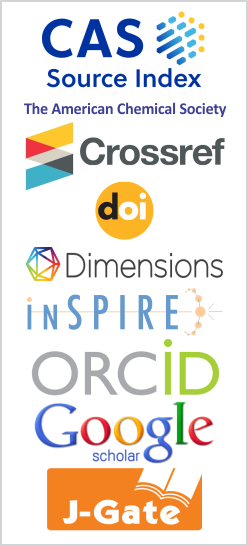High Resolution Auger Projectile Electron Spectroscopy of Li-like Ions Produced by Electron Capture in Collisions of He-like Ions with Gaseous Targets
DOI:
https://doi.org/10.26713/jamcnp.v3i2.523Keywords:
Electron capture, Ion-atom collisions, Zero-degree Auger projectile spectroscopy, Threeelectron spin statistics, K-Auger spectraAbstract
We have recently build a new experimental station with a beam line dedicated to atomic collision physics at the 5 MV TANDEM accelerator of the Institute of Nuclear and Particle Physics at the National Research Center "Demokritos” in Athens, Greece. A complete zero-degree Auger projectile spectroscopy apparatus composed of a single stage hemispherical spectrograph and a 2-dimensional position sensitive detector combined with a doubly differentially pumped gas target has been set up for high resolution studies of electrons emitted from projectile ions excited in collisions with target atoms. With the new setup we have started a systematic isoelectronic investigation of K-Auger spectra emitted from pre-excited ions in collisions with gas targets using novel techniques. Here, we present some of our first new results involving collisions of carbon He-like ions with target gases. These results are expected to lead to a deeper understanding of the neglected importance of cascade feeding of metastable states in collisions of ions with gas targets and further elucidate their role in the non-statistical production of excited three-electron states by electron capture, recently a field of conflicting interpretations awaiting further resolution.Downloads
References
T.J.M. Zouros and D.H. Lee, Accelerator-based Atomic Physics Techniques and Applications, edited by S.M. Shafroth and J. C. Austin (American Institute of Physics Conference Series, Woodbury, NY, 1997), Chapter 13, pp. 426–479.
Atomic Physics with Accelerators-Projectile Electron Spectroscopy http://apapes.physics.uoc.gr/
I. Madesis, A. Dimitriou, A. Lagoyannis, M. Axiotis, T. Mertzimekis, M. Andrianis, S. Harissopulos, E.P. Benis, B. Sulik, I. Valastyán and T.J.M. Zouros, J. Phys.: Conf. Ser. 583, 012014 (2015).
M. Zamkov, E.P. Benis, P. Richard and T.J.M. Zouros, Phys. Rev. A 65, 062706 (2002).
E.P. Benis, M. Zamkov, P. Richard and T.J.M. Zouros, Phys. Rev. A 65, 064701 (2002).
E.P. Benis and T.J.M. Zouros, Nucl. Instrum. Meth. Phys. Res. A 440, 462–465 (2000).
T.J.M. Zouros and E.P. Benis, J. Electron Spectroscopy & Related Phenomena 125, 221–248 (2002), Erratum: ibid. 142, 175-176 (2005).
E.P. Benis and T.J.M. Zouros, J. Electron Spectroscopy & Related Phenomena 163, 28–39 (2008).
O. Sise, M. Dogan, G. Martinez and T. J. M. Zouros, J. Electron Spectroscopy & Related Phenomena 177, 42 (2010).
M. Dogan, M. Ulu, G. G. Gennarakis and T. J. M. Zouros, Rev. Sci. Instrum. 84, 043105 (2013).
E.P. Benis, K. Zaharakis, M.M. Voultsidou, T.J.M. Zouros, M. Stockli, P. Richard and S. Hagmann, Nucl. Instrum. & Meth. Phys. Res. B 146, 120–125 (1998).
E.P. Benis, T.J.M. Zouros and P. Richard, Nucl. Instrum. Meth. Phys. Res. B 154, 276 (1999).
D.H. Lee et al., Phys. Rev. A 44, 1636 (1991); Nucl. Instrum. Methods Phys. Res. B 56/57, 99 (1991).
J.A. Tanis, A.L. Landers, D.J. Pole, A.S. Alnaser, S. Hossain and T. Kirchner, Phys. Rev. Lett. 92, 133201 (2004).
T.J.M. Zouros, B. Sulik, L. Gulyás and K. Tökési, Phys. Rev. A 77, 050701R (2008).
D. Strohschein et al., Phys. Rev. A 77, 022706 (2008).
D. Röhrbein, T. Kirchner and S. Fritzsche, Phys. Rev. A 81, 042701 (2010).
E.P. Benis et al., Phys. Rev. A 73, 0299001E (2006).
D.H. Lee (1990), Ph.D. dissertation, KSU (unpublished).
S.I.S. Inc., SIMION 8.1.2.20, Ringoes, NJ, http://www.simion.com.
S. Doukas, I. Madesis, A. Dimitriou, A. Laoutaris, T.J.M. Zouros and E.P. Benis, Rev. Sci. Instrum. 86 (2015) 043111, http://dx.doi.org/10.1063/1.4917274
S. Doukas et al., Conf. Proc. of the 6th SCCE (2014), pp. 282–288.
Downloads
Published
How to Cite
Issue
Section
License
Authors who publish with this journal agree to the following terms:- Authors retain copyright and grant the journal right of first publication with the work simultaneously licensed under a CCAL that allows others to share the work with an acknowledgement of the work's authorship and initial publication in this journal.
- Authors are able to enter into separate, additional contractual arrangements for the non-exclusive distribution of the journal's published version of the work (e.g., post it to an institutional repository or publish it in a book), with an acknowledgement of its initial publication in this journal.
- Authors are permitted and encouraged to post their work online (e.g., in institutional repositories or on their website) prior to and during the submission process, as it can lead to productive exchanges, as well as earlier and greater citation of published work.




